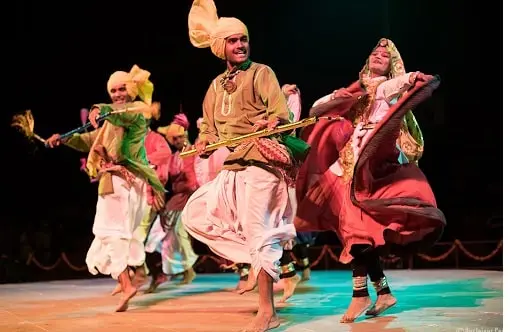Haryana can really stun you with their finest artistic expressions. The dance options are varied. As the cultural tapestry of Haryana is full of vibrancy, the dancing expressions show the perfection of trained dancers. For those interested about the history and culture of Haryana, these dance forms are essential to be discovered.
1. Dhamaal

The colorful Dhamaal dance represents Haryana’s agricultural tradition. This bright dance form, steeped in Haryana’s tradition and customs, symbolizes joy, unity, and brotherhood during festivals and festivities. Dhamaal’s energetic moves and Haryanvi music have shaped Haryana’s culture. Its infectious energy and rhythmic correctness characterize Dhamaal. Traditional dancers are elegant and passionate, making for a dynamic display. Their synchronous clapping matches the dance’s Haryanvi soundtrack. This synchronized rhythm brings Dhamaal to life with Haryana’s pulse. Dhamaal is a joyful unification celebration, not just a dance. It represents Haryana’s close-knit communities, where every occasion is a chance to laugh and enjoy. Haryana’s inhabitants are strong, resilient, and cherish life’s simple pleasures.
2. Phag Dance
Popular Haryana traditional dance Phag Dance celebrates spring. The Hindu month of Phalgun celebrates nature’s beauty and the New Year with this dance. The Phag Dance is comforting because to its gorgeous gestures, sophisticated footwork, and meaningful songs. Lady Phag Dancers use vibrant spring colors. Colorful, intricately embroidered clothes and extravagant embellishments make the dance appealing. Each outfit shows the dancers’ appreciation of the season and love of nature. The Phag Dance’s energy is shown in its captivating choreography. Elegant dancers swing and whirl to Phag tunes. The dance is driven by these songs about love, seasons, and the connection between human emotions and nature’s cycles.
3. Khoria Dance
Khoria Dance, a vivacious dance type, is inspired by Haryana’s young girls. With its fast, rhythmic feet, the dance is a joyful celebration at weddings and other functions. Khoria Dance is happy due to dancers’ synchronized stick percussion movements. Haryana’s lively festivities are represented in this young women-dominated dance form. Colorful costumes reflect the revelry as dancers take center stage. Their vibrant Haryanvi clothing and youthful energy make the Khoria Dance captivating. Khoria Dance has a rhythmic footwork like Haryanvi music. Movements are coordinated to give the dance vitality. They produce happy, excited percussive noises using sticks. This rhythmic correctness makes Khoria Dance attractive.
4. Ghoomar
Rajasthani ghoomar, a global dance, thrives in Haryana. This circle dance, mainly done by women, emphasizes beauty and unity with flowing skirts, colorful veils, and graceful spinning. Ghoomar’s intricate patterns and hand motions represent Haryanvi women’s beauty, grace, and unity. Most of the festivals include Haryana’s cultural icon, Ghoomar. The dancers’ beautiful outfits make Ghoomar appealing. Women execute this dance in colorful skirts with exquisite ornamentation. Their multicolored veils add mystique and make them stand out. Their vibrant clothes swing and swirl, creating a captivating vision of elegance and beauty.
5. Jhumar
Haryana’s Sandal Bar Jhumar dance represents joy, peace, and hospitality. Dancers form rings or semi-circles with their hands in happy fellowship, making this method appealing. Jhumar’s Punjabi folk song will warm you and showcase Haryana’s culture. Punjabi traditional music complements the graceful Jhumar dance. The music highlights the dancers’ elegance and passion. Matching dancing rhythms and tones add charm and elegance. Jhumar’s dance and music stir hearts. Jhumar celebrates Haryana’s hospitality and culture beyond dance. The dancing and Sandal Bar clientele are energetic. Haryana’s close-knit communities are honored with this festive celebration. Elegant, rhythmic swinging and spinning define Jhumar. Dancers’ coordinated swinging and whirling create a river-like scene. Marchers join hands to symbolize Haryana’s peace.
6. Loor
Elegant and antique Haryana Loor dance rules Teej. Local traditions are celebrated in this monsoon and marriage dance. Ladies perform Loor, which includes exquisite hand dances, rhythmic clapping, impassioned storytelling, and brilliant clothing. Teej and women’s history in Haryana are honored by Loor. When monsoon showers revive dry countryside, Loor dance comes life during Teej festival. Women wear bright traditional clothes to commemorate rain’s regeneration and reproduction. Dancers’ bright apparel reflects rainy season colors and passion. Loor choreography intrigues. The dance features elegant hand gestures, rhythmic clapping, and exquisite twirls. The gestures express love, desire, excitement, and celebration. Teej is relevant since dancers tell marital stories with these movements. For millennia, loor has been cultural. This dancing style upholds Haryana values. The dance links past and present to maintain Haryana’s culture.
7. Kharag
Kharag dance, a vibrant traditional art form, commemorates Haryana’s martial heritage. Guys do this sword-based dance to show off their martial skills and courage. The sword motions reflect Haryana’s warrior past. Kharag is a regional emblem used in rituals celebrating the state’s strength. Charag, which means “sword” in Hindi, is a unique dance technique that incorporates combat, choreography, and inventiveness. Kharag commemorates Haryana’s warriors with swords. Each movement reveals the precision and skill required to utilize these deadly weapons.
8. Ras Leela
The sacred and religious dance form Ras Leela is essential to Haryana’s culture. It recreates Krishna and Radha’s eternal love. Dancers connect to the divine with passion and reverence in this spiritual dance. Ras Leela showcases Haryana’s religious and legendary legacy by depicting Lord Krishna’s lovely life with exquisite gestures and emotive storytelling.
9. Teej Dance
Haryana celebrates Teej, especially for married women. The festival highlights include the Teej Dance. The community ladies wear bright colors and jewelry to this boisterous dance. The Teej Dance uses rhythmic dances and expressive gestures to convey marriage’s multifaceted joys and sorrows. It represents the strong bond between women and Haryana’s marital tranquility. Haryana’s married women adore Teej. Celebrating marriage’s blessings and seeking spiritual direction is appropriate. Women perform the Teej do to honor their festival experiences. Bright Teej Dance costumes show festive enthusiasm. Women dress extravagantly and wear sun-glittering jewelry. Their emotions and marital experiences inspire their festival attire.
Conclusion
It is for sure that the dance forms of Haryana are surely eye catchy at every level. The cultural heritage of Haryana shines bright with such artistic expressions. The state of crops, milk and open hearted chats, Haryana offers the craft of the soil through the dances.
Related Topics
Santosh Kumar, the author behind IndiasStuffs.com, is passionate about sharing valuable insights on a variety of topics, including lifestyle, technology, and Indian culture.
Page Contents

